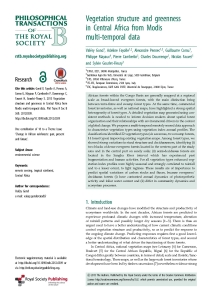Gond V., Fayolle A. , Pennec A., Cornu G., Mayaux P., Camberlin P., Doumenge C., Fauvet N., Gourlet-Fleury S.
African forests within the Congo Basin are generally mapped at a regional scale as broad-leaved evergreen forests, with the main distinction being between terra-firme and swamp forest types. At the same time, commercial forest inventories, as well as national maps, have highlighted a strong spatial heterogeneity of forest types. A detailed vegetation map generated using consistent methods is needed to inform decision makers about spatial forest organization and their relationships with environmental drivers in the context of global change. We propose a multi-temporal remotely sensed data approach to characterize vegetation types using vegetation index annual profiles. The classifications identified 22 vegetation types (six savannas, two swamp forests, 14 forest types) improving existing vegetation maps. Among forest types, we showed strong variations in stand structure and deciduousness, identifying (i)two blocks of dense evergreen forests located in the western part of the study area and in the central part on sandy soil; (ii) semi-deciduous forests are located in the Sangha River interval which has experienced past fragmentation and human activities. For all vegetation types enhanced vegetation index profiles were highly seasonal and strongly correlated to rainfall and to a lesser extent, to light regimes. These results are of importance to predict spatial variations of carbon stocks and fluxes, because evergreen/deciduous forests (i) have contrasted annual dynamics of photosynthetic activity and foliar water content and (ii) differ in community dynamics and ecosystem processes.
Consultez la notice complète de l’article sur ORBi

